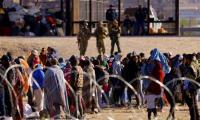LAHORE: Despite highly improved macro-economic stability, growth in Pakistan is much below expectation due to the underperformance of the agriculture sector that accounts for 21 percent of the GDP, bringing miseries for its 65 percent population, mostly living in rural areas.
Agricultural commodity rates are at their lowest since 2009 according to Food and Agriculture Organization (FAO). Sugar price index fell by 4.1 percent in December 2015 compared with the corresponding month of 2014. While dairy rates eased by three percent, a decline of 1.7 percent was witnessed in cereal rates, whereas vegetable and meat prices declined by 1.7 percent and 1.1 percent respectively.
Still, the rates of agriculture commodities are very high in Pakistan. We produce these commodities in sufficient or surplus quantities, but our consumers pay 40 percent more for wheat, 20 percent more for rice, and 30 percent more for milk. Vegetable oil prices are almost at 2008 peak level.
This gives an impression that the farmers in Pakistan are making huge profits compared with rest of the world, which is not true.
Dairy farmers’ part with their produce at a low price of Rs36-45 per litre, the milk vendors sell unprocessed milk at Rs70-80 per litre, and the milk processors sell it at over Rs100 per litre. Soya oil import price has decline substantially, but the oil processors continue to sell at high rates.
When vegetable oil rates were high in the global markets, the processors used to pay the local farmers at par with the global rates of oil seeds. Now that the prices have gone down by over 30 percent they have also reduced the price of local oil seed. Local oil seed accounts for around 30 percent of the vegetable oil produced in Pakistan. The farmer of oil seed has got the global rates but the processors are minting money on end product. The decline in global commodity rates has badly hit its farming sector.
Even the lopsided support that the government provides to some specific crops has not benefited the farmers. For instance, efforts of successive governments to increase the support price of wheat have also backfired as the domestic wheat rates are 40 percent higher than global rates resulting in higher wheat production and creating a huge surplus.
The government procures 25 percent of the crop on support price while the rest is bought by private sector at much lower rates. The government has levied sales tax and other levies on agricultural inputs, which if withdrawn could reduce the wheat support price to the global level and bring relief to farmers. On the other hand, the support to rice, sugarcane, and cotton farmers was tacitly withdrawn. The sugarcane farmers are moving from pillar to post to get their payments from the sugar mills. Rice farmers are at the mercy of exporters and local middlemen. Cotton farmers are facing the music as they had to buy much higher quantity of highly taxed pesticide to protect their crop from pest attack. Their failure to do so resulted in much higher costs and very low yield.
With a weight of 21 percent in Pakistan’s GDP, an agricultural growth of five percent could boost the overall GDP 1.25 percent. At current growth of around 1.5 percent it is merely 0.30 percent in the growth.
A little attention on the agricultural sector can increase our GDP growth from projected 4.5 percent to 5.5 percent. Increasing agricultural growth is also important from the poverty perspective as well. According to the World Bank majority of the poor live in rural areas. In Pakistan, the incidence of poverty is accordingly much higher in rural area where the majority of our farmers live. By increasing the growth rate of agriculture we could reduce much of the rural poverty.
Another point that should be noted by our planners is that the rural economy is currently relatively less dependent on agriculture because of the decline in average landholdings. Over 88 percent of the farmers in Pakistan now fall under the marginal category. Majority of the cultivated area is looked after by them. Since these farmers cannot meet their household expenses they are forced to combine nonfarm work for survival. They work in construction and other fields at much below the urban wages and even after supplementing the income derived from crops remain poor. The challenge for our economic planners is to devise policies for the revival of dynamism in agriculture, keeping climate change in mind; and creation of quality employment in nonfarm sectors.
Farrukh H Sabzwari addresses an event at Central Depository Company of Pakistan in this undated photo. —...
Representational image of vocational training students doing practice. —TheNews/FileKARACHI: The Sindh government...
Women inspecting pink salt stacks at Pakistan's stall in World Expo 2025. —Instagram@pakatworldexpo/FileKARACHI:...
A representational image of gold bangles. — AFP/FileKARACHI: Gold prices increased by Rs600 per tola on Tuesday in...
Fiza Farhan. —Linkedin@fiza-farhan/FileKARACHI: Fiza Farhan, CEO of ORA Global Development Advisors and a leading...
US Health Secretary Robert F Kennedy Jr. visits the Osher Center for Integrative Health at the University of Utah in...







